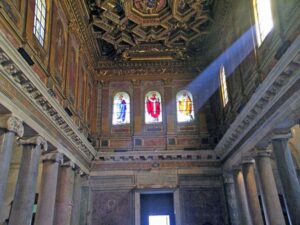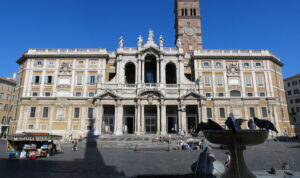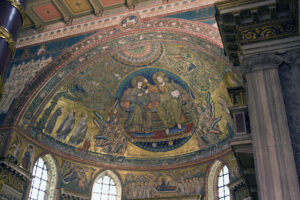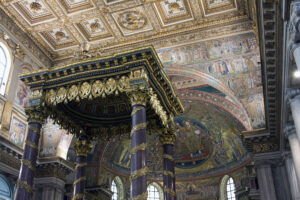Another article in a series on the history of Rome, Italy.
Rome’s Trastevere District
Trastevere is a district of Rome to the west, officially Rione XIII. “Trastevere” (trahs TAY veh ray) means “Across the Tevere.” “Tevere” is the Italian name for the Tiber, the large river that flows through Rome. It is an ancient and medieval district full of narrow lanes and twisting alleyways. It is also home to two interesting very early Christian churches, Santa Cecilia and Santa Maria in Trastevere.
Santa Cecilia
The church is dedicated to St Cecilia, a 2nd century Roman martyr and patron of musicians. The Italian pronunciation is “chay CHEE lee ah.”
The first church on the site was built in the either 3rd or the 5th century, during excavation work its baptistery was discovered beneath the present Chapel of Relics.
The church was rebuilt in the early 9th century and St Cecilia’s remains were brought from the catacombs of St Calixtus to the church. It was rebuilt-remodeled again in the 18th century.
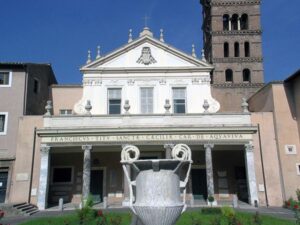 Façade
Façade
The front façade was designed in 1725; enter through the monumental entry and into the courtyard. In front of the church building proper is a garden courtyard with an ancient water vessel adapted as a fountain.
The campanile is from the 12th or 13th century.
The 24 Corinthian columns are from the first church.
Stefano Maderno’s beautiful sculpture of Cecilia is in front of the sanctuary. The discovery of her body by Pope Paschal in a catacomb in the 9th century is depicted in a 12th or 13th century fresco at the end of the aisle. Her body was brought to the church and re-interred after the discovery. Her tomb was reopened in 1599 and her body was apparently found intact and incorrupt. Maderno made a sculpture of her; his inscription can still be seen on the floor, testifying that she was depicted just as he saw her.
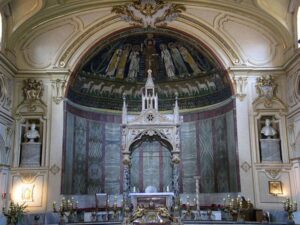 Apse
Apse
The Gothic canopy was made, and signed, by Arnolfo di Cambio in 1292. It is supported by four columns of black and white marble and has Cosmatesque decoration.
The Byzantine style apse mosaic dates from 820 and depicts Christ in Roman clothes being crowned by the Hand of God. He is wearing lati clavi, which was a sign of high rank in Roman society. He is flanked by from left to right; St Paul, St Cecilia, Pope Paschal I, St Peter, St Valerian and St Agatha. Below them on the band 12 lambs surrounding the Lamb of God are seen leaving Jerusalem and Bethlehem. The church’s upper gallery was originally a women’s gallery and is now the nun’s choir
Excavation
Santa Cecilia is built upon an Imperial Era house. You can see the excavations; the ticket office is at the rear of the church on the left side as you enter.
Roman houses from the 2nd and 3rd century have been excavated. One of them is supposedly St Cecilia’s. Evidence of Republican period buildings have also been found. Back then this area was a commercial district; the brick basins uncovered indicates that it was owned by a craftsman; possibly a tanner.
Santa Maria in Trastevere
Some sources say this is the first church where Mass was celebrated openly. Legend surrounds this church’s founding; some information puts its construction at 221, although mid 4th century is more likely. It was rebuilt in the mid 12th century and again in the mid 19th century. Santa Maria in Trastevere contains an odd mixture of Ancient Roman artifacts and construction and early, medieval and relatively new Christian art and architecture.
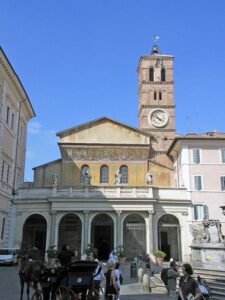 Façade
Façade
The façade was rebuilt in 1702; the four Baroque statues above the portal depict Sts Calixtus, Cornelius, Julius and Calepodius. The mosaics are 12th century. They depict the parable of the wise and the unwise maidens. The Blessed Virgin is in the center. The right side maidens are crownless and have allowed their lamps to extinguish.
The door has recycled Imperial Rome stone cornices and the narthex contains a collection of pagan and early Christian inscriptions (3rd century) on the wall and fragments of 9th century sculpture and medieval paintings. The sarcophagi are from the 3rd and 4th centuries.
The campanile is 12th century.
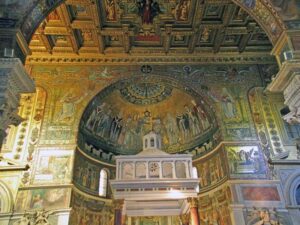 Apse and Arch Mosaics
Apse and Arch Mosaics
The spectacular main apse mosaic is also from the 13th century remodel project and is attributed to Pietro Cavallini. Christ and St Mary are enthroned and flanked by saints and popes. The mosaic’s left side shows Pope Innocent II holding a model of the church, St Lawrence and Pope St Callixtus. On the right side are Peter and Pope St Cornelius, Pope St Julius and St Calepodius.
The panels between the windows are also mosaics and are late 12th century. They show scenes from the life of the Blessed Virgin. From the left they are: The Birth of Our Lady, The Annunciation, Nativity, Epiphany, Presentation in the Temple and The Falling Asleep of Mary. The last one shows the soul of Mary in the arms of Our Lord.
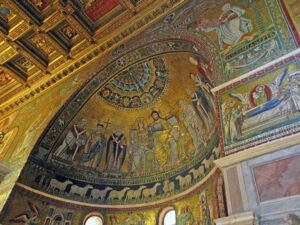 The triumphal arch’s frescoes are 19th century, the episcopal throne in the apse is ancient.
The triumphal arch’s frescoes are 19th century, the episcopal throne in the apse is ancient.
Weird Stuff
And now for some of the oddness that is Santa Maria in Trastevere.
Inside the church in various places are the Latin words “Fons Olei (oil spring).” Legend has it that a crude oil spring bubbled up here during Augustus’ rule. The local Jewish community interpreted it as a sign that God’s grace would soon flow into the world. Later, because of this interpretation, this location became a meeting spot for the first Roman converts to Christianity.
Another oddness; at the steps at the end of the right aisle you can see some black marble weights. These are ancient standard weights, which the Romans first kept in the temples and later in the churches.
